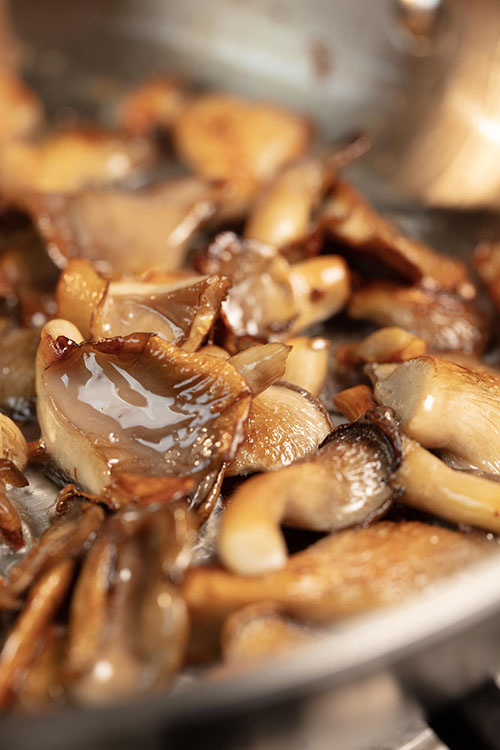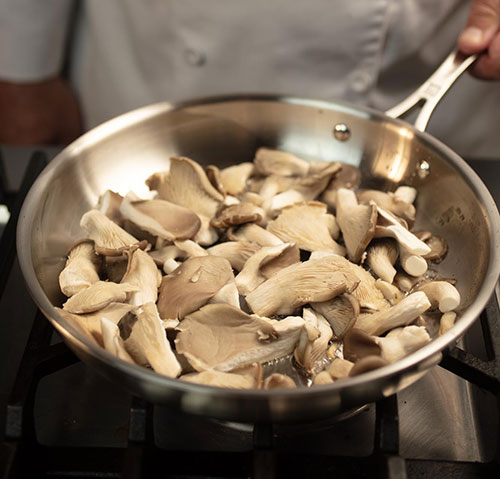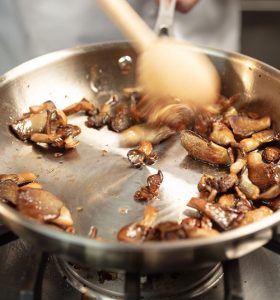A beautifully golden brown mushroom that’s slightly crisp on the exterior, but tender and flavorful on the interior, is not a difficult outcome to achieve. And yet, it is one of the biggest challenges for CIA students and home-cooks alike. 
After observing the struggles to cook mushrooms with results that are soggy and pale, full of moisture and light on flavor, we have identified the 5 things you need to know to make perfect mushrooms, ready for a steak dinner, as a salad topper, or to tuck into tacos.
1. Embrace the Heat
Sautéing is the best choice to make perfectly browned mushrooms, and the key to sautéing is a HOT pan. Moist foods cannot brown until the water has evaporated from the surface of the ingredient. Mushrooms are wet sponges, and as they cook, the water escapes from the mushroom and into the pan. In a hot pan, this water seeps out and then quickly evaporates, leaving the pan and mushrooms dry and ready to brown. When the pan is too cool, the water doesn’t evaporate quickly, which leaves the mushrooms to steam or boil in their own juices. If you see liquid accumulating at the bottom of your pan, try turning up the heat for a good sizzle.
2. Avoid Overcrowding
 We always say not to overcrowd the pan, but that’s especially important for mushrooms. Just like a cold pan can cause the mushrooms to cook in their liquid, a crowded pan has the same effect. With no surface area available, due to a full pan, the moisture is slow to evaporate. In addition, if your mushrooms are crowded in layers, some mushrooms won’t connect with the heat of the pan, and so they will cook unevenly and improperly.
We always say not to overcrowd the pan, but that’s especially important for mushrooms. Just like a cold pan can cause the mushrooms to cook in their liquid, a crowded pan has the same effect. With no surface area available, due to a full pan, the moisture is slow to evaporate. In addition, if your mushrooms are crowded in layers, some mushrooms won’t connect with the heat of the pan, and so they will cook unevenly and improperly.
3. Don’t Skimp on Oil
Your pan works as a conductor that transfers the heat of your stove to the food you’re cooking, but it doesn’t work alone. Fats, like oil or butter, are heated by the pan before coating your mushrooms, conducting heat evenly over the surface of the mushrooms. Without enough fat to coat your mushrooms, they will not brown evenly, leading to mushrooms that are brown around the edges, but wet and less flavorful throughout.
4. Let Them Cook
Heat your pan and oil, and then add your mushrooms. While you may be tempted to go in with your spoon and start stirring and turning, take a few beats and let the mushrooms sear in the hot pan for a few minutes before moving them. After every stir or flip, give them a little more time than usual to brown before moving them again.
5. Deglaze the Pan
Well-seared and browned mushrooms will leave flavorful bits at the bottom of your pan that should never be discarded. Deglaze the pan with a splash of stock, wine, or even just water. This will release those bits and incorporate them back into your mushrooms. Be sure to let the liquid evaporate fully before removing from the heat. At this point, you can add any finishing ingredients, like butter or herbs.


